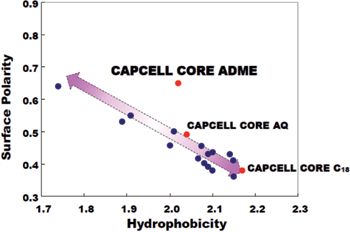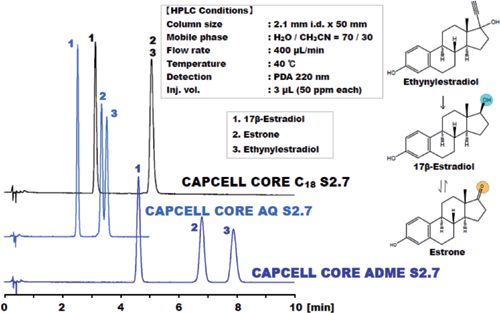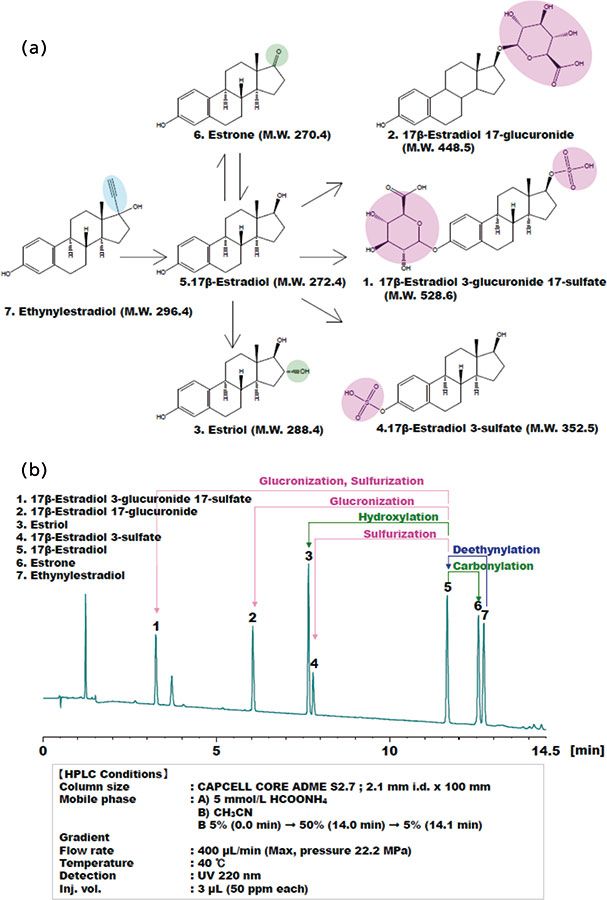CAPCELL CORE ADME S2.7, a Novel Adamantyl Stationary Phase, Alternative to C18 for Improved Separation of Metabolites
The Application Notebook
CAPCELL CORE ADME S2.7 (ADME) is a column packed with a novel stationary phase of superficially porous silica (core shell particle) modified by adamantyl functional groups.
CAPCELL CORE ADME S2.7 (ADME) is a column packed with a novel stationary phase of superficially porous silica (core shell particle) modified by adamantyl functional groups. ADME has separation characteristics with a balance between moderate hydrophobicity and extra-high surface polarity, which is completely different from the conventional C18. Therefore, ADME could provide separation patterns and separation improvement previously unavailable in C18 with increased retention to highly polar compounds. It is also expected as a significant alternative to C18 column for improved separation of samples having diverse polarities such as metabolites and the matrix in real samples.
The C18 column is the most popular one used in reversed-phase chromatography, but has difficulty in retaining highly polar compounds. As a solution, high polar columns applicable in 100% aqueous mobile phase (1) or changing the separation mode to hydrophilic interaction chromatography (HILIC) (2) accompanied with re-setup of the analysis condition are considerable, but troublesome or with limitations. Meanwhile, in recent years, comprehensive analysis of metabolites has raised the need for simultaneous analysis of multi-component comprising highly polar metabolites and highly hydrophobic compounds before metabolism not only in pharmacokinetics fields.
Shiseido succeeded in the development of CAPCELL CORE ADME S2.7 (ADME), a novel stationary phase with surface modification of Adamantyl functional group which is completely different with the C18. ADME is easy to use just as a general reversed-phase column since its functional group is also alkyl group only with changed structure.
In this study, the characteristics of CAPCELL CORE ADME S2.7 (ADME) and the separation behavior of highly polar compounds with ADME column were evaluated.
Experimental
Basic feature of CAPCELL CORE ADME S2.7
1. Determination of separation parameters
CAPCELL CORE ADME S2.7 (ADME) is a column packed with a novel particle with 1.7-µm solid core and 0.5-µm porous layer modified with adamantyl functional group (Figure 1). The parameters of hydrophobicity and surface polarity were determined with ADME by the resolution factors of toluene with benzoate, and toluene with methyl benzoate, respectively (3).

Figure 1: Superficially porous particle modified by adamantyl functional groups.
2. Comparison of separation characteristics
The effect of separation parameters on retention and separation were determined by comparison of the analysis of ethynyl estradiol and its metabolites with CAPCELL CORE C18 S2.7 and CAPCELL CORE AQ S2.7, respectively.
3. Application of CAPCELL CORE ADME S2.7
Ethynyl estradiol, its relative substances and conjugated metabolites were analyzed with CAPCELL CORE ADME S2.7.
Results and Discussion
Basic feature of CAPCELL CORE ADME S2.7
(1) Determination of separation parameters
In Figure 2, the parameters of hydrophobicity and surface polarity of CAPCELL CORE ADME S2.7 derived from the resolution factors of toluene with benzoate, and toluene with methyl benzoate were plotted on the parameter graph including CAPCELL CORE C18 S2.7, CAPCELL CORE AQ S2.7, and other reversed-phase columns. In the parameter map, ADME is positioned at moderate hydrophobicity and extra-high surface polarity.

Figure 2: Parameter map of separation.
(2) Comparison of separation characteristics
As shown in the chromatograms in Figure 3, CAPCELL CORE ADME S2.7 performed with improved separation compared with more hydrophobic CAPCELL CORE C18 S2.7 and similarly hydrophilic CAPCELL CORE AQ S2.7. Therefore, it is suggested that not only the hydrophobicity but also the high surface polarity of ADME provided effect on the separation of ethynyl estradiol and its metabolites (17-β estradiol and estrone).

Figure 3: Chromatograms of nithynyl estradiol and its metabolites.
Application of CAPCELL CORE ADME S2.7
Ethynyl estradiol and its conjugated metabolites containing glycoside were analyzed under gradient condition with CAPCELL CORE ADME S2.7 (Figure 4b). It is clear that the metabolites of ethynyl estradiol, conjugate of sulfuric acid and glucuronic acid were certainly separated in the simultaneous analysis of multi-components comprising unchanged ethynyl estradiol and its relative metabolites in different stages (Figure 4a).

Figure 4: (a) Metabolic pathway of ethynylestradiol. (b) Simultaneous analysis of nithynyl estradiol relative substances.
Conclusion
CAPCELL CORE ADME S2.7 is a novel core-shell type column with adamantyl-functional group modified stationary phase and provides improved separation to highly polar metabolites which is previously unavailable by the conventional C18 columns. ADME is easy to use as a reversed-phase column and expected as a significant alternative solution to C18 in the simultaneous analysis of metabolites and the separation of matrix in a real sample.
References
(1) T. Kanda, J. Chromatogr. A 32, 95–100 (2011).
(2) A.J. Alpert, J. Chromatogr. A 499, 177–196 (1990).
(3) S. Kobayashi, I. Tanaka, O. Shirota, T. Kanda, and Y. Ohtsu. J. Chromatogr. A 828, 75–81 (1998).

Shiseido Co., Ltd.
4F Shiodome Bl., 1-6-2, Higashi-shinbashi, Minato-ku, Tokyo, Japan
tel. +81-3-6253-1412
Website: hplc.shiseido.co.jp/e/

SEC-MALS of Antibody Therapeutics—A Robust Method for In-Depth Sample Characterization
June 1st 2022Monoclonal antibodies (mAbs) are effective therapeutics for cancers, auto-immune diseases, viral infections, and other diseases. Recent developments in antibody therapeutics aim to add more specific binding regions (bi- and multi-specificity) to increase their effectiveness and/or to downsize the molecule to the specific binding regions (for example, scFv or Fab fragment) to achieve better penetration of the tissue. As the molecule gets more complex, the possible high and low molecular weight (H/LMW) impurities become more complex, too. In order to accurately analyze the various species, more advanced detection than ultraviolet (UV) is required to characterize a mAb sample.

.png&w=3840&q=75)

.png&w=3840&q=75)



.png&w=3840&q=75)



.png&w=3840&q=75)














